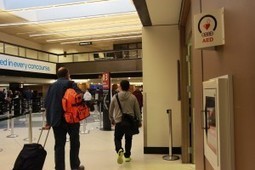See on Scoop.it – Defibrillation
Seattleites can join in a life-saving scavenger hunt. Players will compete to identify and report the locations of Seattle’s automatic external defibrillators, or AEDs, for a cash reward. Prizes range from $50 to $10,000.
AEDs are electronic briefcase-size devices designed to allow bystanders on scene at a medical emergency to help someone who has collapsed with loss of mechanical activity of the heart, or cardiac arrest.
“Our list of AED locations may be incomplete. We are seeking the public’s help to learn where more of these devices are,” said Dr. Graham Nichol, University of Washington professor of medicine in the Center for Pre-Hospital Emergency Care at UW Medicine’s Harborview Medical Center.
AEDs are cost-effective lifesavers that are often placed where cardiac arrests are most likely, such as airports, sports clubs and shopping malls, according to Nichol, who explained why it is important for a bystander to be able to locate an AED immediately.
“Cardiac arrests are a leading cause of death in the United States but can be treated if recognized and responded to quickly with an AED.”
Often cardiac arrest is due to ventricular fibrillation, in which the lower chambers of the heart quiver instead of contracting in a steady beat. AEDs simplify analysis of the heart rhythm. This enables lay people to recognize and treat ventricular fibrillation before emergency medical services providers arrive. Each device has voice and visual prompts that guide bystanders through the necessary steps.
More than 1.2 million AEDs are now in public places in the United States, and about 180,000 more are installed each year. Sometimes bystanders cannot find the nearest AED during a medical emergency. That’s where the My HeartMap Seattle challenge comes in. Game players will assist UW clinicians by reporting the location of AEDs in community settings throughout Seattle.
Here are the basic rules of the game.
The contest starts Tuesday, Oct.15, and ends Friday, Nov. 15. Complete your free registration to participate in the contest. When you locate an AED in Seattle, report a brief description of it on the contest website, including the building address for the AED, its location within the building, and whether the device appears to be ready for use. A $10,000 grand prize will be awarded to the individual or team that identifies the most unique AEDs. “Unique” means no other player or team has already found the AED. The grand prize will be “unlocked” when at least one individual or team identifies 500 AEDs or all contest participants collectively identify 750 AEDs. Twenty $50 prizes are also available. Twenty AEDs in the city of Seattle have been pre-selected by the research team as “Golden AEDs.” These are unmarked, and those who are first to report a “Golden AED” will win $50. You can follow MyHeartMap Seattle on twitter (@cprnation, #MyHeartMapSeattle) or at the CPR Nation website.
The AED scavenger hunt aims to build public awareness about AEDs, which are commonly contained in a clear glass wall box, sometimes near a fire extinguisher. The spot is generally marked with a symbol of an electrical charge passing through a heart shape.
The contest is modeled after a similar Philadelphia County project at the University of Pennsylvania, which in turn adapted an approach from the Defense Advanced Research Projects Agency for its Red Balloon Challenge. Dr. Raina Merchant, University of Pennsylvania assistant professor of emergency medicine, directed the My HeartMap Philadelphia Challenge. She is the director of the Penn Medicine Social Media Lab and an expert in the use of digital strategies to educate the public on at-the-scene emergency aid. Merchant is collaborating with UW scientists on the My HeartMap Seattle Challenge.
“This is an exciting collaboration that could have a real impact on access to emergency care in Seattle and other regions throughout the country,” noted Merchant.
During the MyHeartMap Philadelphia challenge, participants submitted data about AED locations via a website and a phone app. Some 313 individuals and teams reported more than 1,400 AEDs. Prizes were given for reporting the most AEDs found or for being the first to report the location of specific previously selected devices.
“Most people realize that AEDs are simple enough to use,” Nichol said. “Just follow the voice and visual prompts. They are designed to provide a shock only when needed.”
An AED is usually activated by opening its lid. The commands then begin with visual, recorded and text instructions for baring the patient’s chest and sticking on the pads. Then the machine asks everyone to step back while it analyzes the heart rhythm. It repeats the request to stand clear if it decides to administer a shock. If the rhythm suddenly normalizes before a shock is delivered, the machine will report a rhythm change and announce that no shock will occur.
Most machines also instruct in CPR and coach the timing of compressions and breaths.
“My HeartMap Seattle will help us improve care for patient with out of hospital cardiac arrest,” Nichol said. “The methods and results of this AED scavenger hunt in Seattle will be applied to scavenger hunts in other large cities throughout the United States. In the future, we will have a comprehensive record of AED locations throughout the country.”
My HeartMap Seattle is funded by the U.S. Food and Drug Administration, Zoll Medical Inc., Philips Healthcare Inc., Physio-Control Inc., HeartSine Technologies Inc. and Cardiac Science Inc.
The collaborating sponsors include the American Heart Association, Medic One Foundation, Nick of Time Foundation, University of Pennsylvania and University of Washington.
See on www.washington.edu



 Follow
Follow